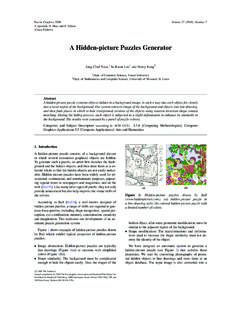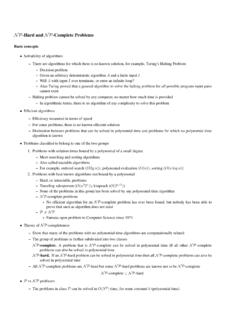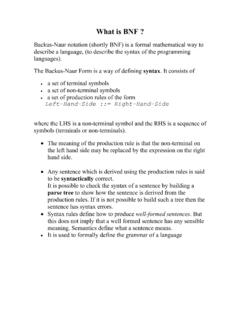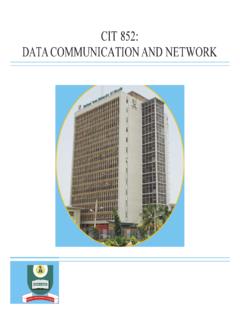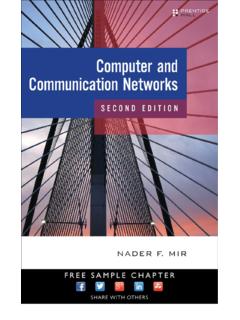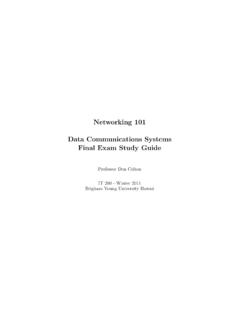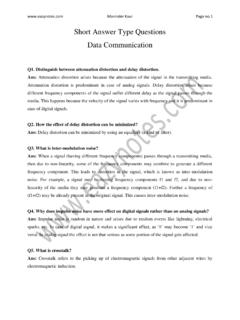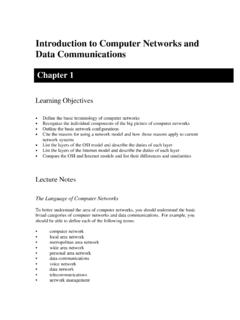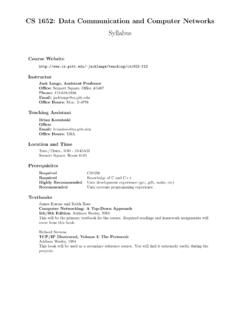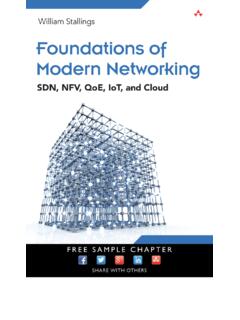Transcription of Introduction Computer Network. Data Communications ...
1 IntroductionComputer collection of autonomous computers that are able to exchange information No master/slave relationship between the computers in the networkData of signals in a reliable and efficient and architecture of Communications networks used to interconnect communicating devicesA Communications Model Purpose of a Communications system Exchange of data between two entities Key elements of the model Source Entity that generates data Person who speaks into the phone, or Computer sending data to the modem Transmitter Device to transform/encode the signal generated by the source The transformed signal is actually sent over the transmission system Modem transforms digital data to analog signal that can be handled by telephone network Transmission system Medium that will allow transport of signal from one point to another Telephone network for our Computer /modem example Receiver Device to decode the received signal for handling by destination device Modem converts the received analog data back to digital for use by the Computer Destination Entity that finally uses the data Computer on the other end of receiving modem Tasks to be accomplished in the model Transmission system utilization Efficient use of transmission network typically shared among a number of communicating devices Multiplexing is used to share the total capacity of network among a number of consumers Congestion control to ensure that the system does
2 Not get overwhelmed by excessive transmissionnetwork demand Interface Point of interaction or communication between two entities, such as a device and the transmissionsystem communication is achieved throughsignal generation Properties of signal Possible to propagate through the transmission system Possible to interpret as data by the receiver SynchronizationIntroduction2 Operation of transmitter and receiver in unison Receiver must be able to determine when a signal begins to arrive and when it ends Receiver must also know the duration of each signal element Exchange management Need for cooperation between two entities for bidirectional data transfer Conventions or protocols to decide whether data is transferred simultaneously by more than one entityin a network connection or whether they take turns Other things to worry about are the amount of data to be transferred, data format, and error detec-tion/correction capabilities Error detection/correction Signal may get distorted during transmission Cannot afford to alter the contents of data being transmitted Imagine if this file gets some bits changed in every sentence while you download it, and does so indifferent locations for every download Flow control Collection of techniques used in serial Communications to stop the sender sending data until thereceiver can accept it Receiver typically has a fixed size buffer into which received data is written as soon as it is received.
3 When the amount of buffered data exceeds a high water mark, the receiver will signal to the trans-mitter to stop transmitting until the process reading the data has read sufficient data from the bufferthat it has reached its low water mark, at which point the receiver signals to the transmitter toresume transmission Addressing/Routing Source must identify the identity of intended destination in a shared network Transmission system must ensure that only the intended destination receives the data The transmission system may choose any of the various available routes to deliver the data ; it mayeven send data in parts with each part taking a different route Recovery In the event of transmission interruption, should the transmitter resend entire data , or send theremaining data only from the point of interruption Message formatting Preestablished patterns of signals between transmitter and receiver Security Safe delivery of data to intended recipient only data should not get modified during transmission data must be authenticated to be from the sender only network management Configure the system Monitor system status React to failure and overload Plan for future growthData Communications Where is data while it is traveling between different entities within the Communications model, and what formis it in?
4 Introduction3 It could be in the form of a sequence of bits, or sequence of voltage shifts, or a signal suitable fortransmission Email example Keyboard receives data and puts it in Computer memory as a sequence of bitsg data goes from memory to modem over local Communications bus of the Computer , and is denotedbyg(t) during this transition phase It is picked up by modem (transmitter) and converted to sequence of voltage shifts (digital-to-analogconversion) which are sent over the network ( Communications medium); data are now denoted bys(t) Finally, the signal reaches the destination (receiver) asr(t) because it may get modified during thetransmission by addition of noise Receiver attempts to recover the signalg(t) fromr(t) and produces a sequence of bitsg (t) The final messagem should generally be as close tomas possible, ideally an exact copy ofm Other aspects of data Communications are data flow control, error detection and correction, and multiplexingfor transmission efficiencyNetwork hardware and transmission technology Broadcast networks Single communication channel shared by all machines on the network Short messages, orpackets, are sent from one machine and received by all machines Address field within the packet specifies intended destination Packet not intended for a machine is ignored by that machine Multicasting Transmission is sent only to a subset of machines Possible by reserving one bit in the address field to indicate the presence of multicasting.
5 With re-maining bit holding a group number A machine cansubscribeto one or more groups Packet sent to a group is delivered to all machines in that group Typically used for smaller localized networks Point-to-point networks Many connections between individual pairs of machines Packet may visit intermediate nodes on its way to the destination Routing algorithms are important for deciding a route in these networks Typically used for large networksData communication networking Impractical to connect every pair of communicating devices directly as point-to-point connection Any pair of devices may be very far apart, making it expensive to have multiple dedicated links A set of devices may require a link to many other devices at different times, for example telephones in anorganization (all telephones atumsl Problem can be solved by attaching each device to a communication network Most networks can be categorized into one of the two classes: wide area networks and local area networksIntroduction4 Internetwork Connection of two or more networks Exemplified by internet Wide Area Networksorwans Generally spread over a large geographic area, from across the city to across the continent (100-1000 km))
6 Require crossing public area and may rely on circuits provided by a common carrier Typically is made up of a number of interconnected switching nodes Transmission from one device goes through internal nodes of the network to a specified destination device Nodes are not concerned with the contents of the message but just bounce the message to the next nodetowards the destination Implemented using circuit switching, packet switching, frame relay, oratm Circuit switching A dedicated communication path is established between source and destination through the networknodes Path is a connected sequence of physical links between nodes On each link, a logical channel is dedicated to the connection data from the source is transmitted through the dedicated link as fast as possible No delay between reception and retransmission of data at each node Best example is the telephone network Packet switching No dedicated transmission capacity along a path data are sent in terms of packets Packets travel through the network from node to node At each node.
7 Packet is received and stored briefly before being transmitted to the next node Commonly used for Computer -to- Computer Communications Considerable amount of overhead to compensate for errors Additional bits to add redundancy and extra processing at each node for error detection and correction Average data rate of about 64kbps Frame relay Removes the disadvantage of extra overhead in packet switching Takes advantage of high transmission speed and low error rates in modern networks Uses variable length packets called frames Most of the overhead is stripped with error control Operates efficiently to about 2 Mbps Asynchronous transfer mode oratm Also known as cell relay Commercial state-of-the-art networks Uses fixed length packets called cells to reduce the processing overhead Provides little overhead for error control, depending on inherent reliability of transmission networkand higher order logic at stations for error detection and recovery Works in the order of 10 100 Mbps range and may even achieve Gbps range atmvs.
8 Circuit switching Circuit switching allows only fixed- data -rate circuits for the end systems atmallows multiple virtual channels with data rates that are dynamically defined at the time ofcreation of virtual channelIntroduction5 atmis efficient due to the use of small fixed-size cells allowing it to offer a constant data ratechannel while using packet switching data rate on each channel in the system can be dynamically set on demand isdnand Broadbandisdn Integrated services digital network Designed to replace existing public telecom network while delivering a wide range of services Multiple networks within national boundaries with a single, unified view dictated by user interfacestandards First generation ornarrowbandisdn Uses 64kbps channel with circuit switching and frame relay Second generation orbroadbandisdn Supports high data rates at 100s of Mbps with packet switching andatm Local Area Networksorlans Smaller scope compared towans, typically a single building or campus (10m 1km) Distinguished from other networks by size, transmission technology, and topology Small size restriction binds the worst-case transmission time and simplifies network management Internal data rates onlans are much greater than those ofwans Make use of a broadcast network approach rather than a switching approach No intermediate switching nodes Transmitter/receiver at each node communicates over a medium shared by other nodes Transmission from any station is received by every other station data are transmitted in packets, allowing only one station to transmit at any given time Generally use a single cable for transmission to which all machines are attached Traditional speed is 10-100 Mbps, with low delay (10s of s)
9 , with fewer errors lantopologiesBus'&$%Ring Bus or linear cable network At any point of time, one machine becomes master and transmits Other machines cannot transmit at the same time Conflicts, when two machines want to transmit at the same time, are resolved by some arbitrationmechanism Best example is Ethernet ( ), with decentralized control operating at 10-100 Mbps If nodes on Ethernet collide in packet transmission, each node waits for random time and triesagain RingIntroduction6 Each bit propagates around the network , without concern for rest of the packet Each bit may go around the ring even before the entire packet is transmitted Best example isibmtoken ring ( ) operating at 4 and 16 MbpsProtocols and protocol architecture In addition to data path, we need to account for other factors in communication network Source must identify the destination to the network Source must make sure that destination is prepared to accept data Security must be accounted for.
10 data should go to the intended user on the receiver Incompatible file formats may need to be translated Computer communication Exchange of information between computers for cooperative action Protocol Set of rules governing the transfer of data between entities Used for communication between entities in different systems For two entities to communicate, they must speak the same language communication must follow some mutually acceptable conventions, referred to as protocol Key elements of a formats and signal information for coordination and error matching and sequencing Protocol architecture Cooperation between computers is broken into a number of tasks, with each task implemented separately Three-Layer Model Communications can be abstracted in terms of three agents: applications, computers, and networks File transfer operationApplication Computer network Computer Application Organize the Communications task into three relatively independentlayers1.
